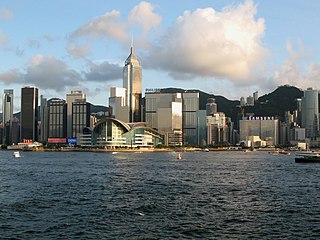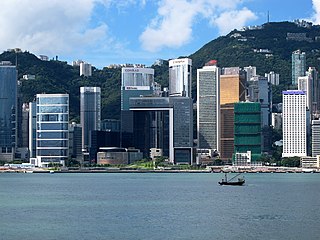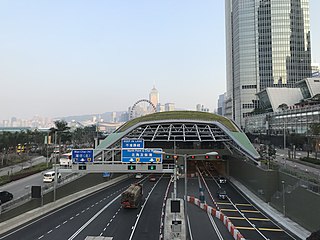
Wan Chai is located in the western part of Wan Chai District on the northern shore of Hong Kong Island,Hong Kong. It is bounded by Canal Road to the east,Arsenal Street to the west,and Bowen Road to the south. The area north of Gloucester Road is often called Wan Chai North.

Hong Kong Island is an island in the southern part of Hong Kong. The island,known originally and on road signs simply as "Hong Kong",had a population of 1,289,500 and a population density of 16,390 per square kilometre (42,400/sq mi),as of 2023. It is the second largest island in Hong Kong,with the largest being Lantau Island. Hong Kong Island forms one of the three areas of Hong Kong,with the other two being Kowloon and the New Territories.

Central,also known as Central District,is the central business district of Hong Kong. It is located in the northeastern corner of the Central and Western District,on the north shore of Hong Kong Island,across Victoria Harbour from Tsim Sha Tsui,the southernmost point of Kowloon Peninsula. The area was the heart of Victoria City,although that name is rarely used today.

The Star Ferry is a passenger ferry service operator and tourist attraction in Hong Kong. Its principal routes carry passengers across Victoria Harbour,between Hong Kong Island and Kowloon. The service is operated by the Star Ferry Company,which was founded in 1888 as the Kowloon Ferry Company,and which adopted its present name in 1898.

Victoria Harbour is a natural landform harbour in Hong Kong separating Hong Kong Island in the south from the Kowloon Peninsula to the north. The harbour's deep,sheltered waters and strategic location on South China Sea were instrumental in Hong Kong's establishment as a British colony in 1841 and its subsequent development as a trading centre.

Admiralty is the eastern extension of the central business district on the Hong Kong Island of Hong Kong. It is located on the eastern end of the Central and Western District,bordered by Wan Chai to the east and Victoria Harbour to the north.

The Hong Kong Convention and Exhibition Centre (HKCEC) is one of the two major convention and exhibition venues in Hong Kong,along with AsiaWorld–Expo. It is located in Wan Chai North,Hong Kong Island. Built along the Victoria Harbour,it is linked by covered walkways to nearby hotels and commercial buildings. The venue was designed by Skidmore,Owings &Merrill LLP,in association with Wong &Ouyang (HK) Ltd. Larry Oltmanns led the design as the Design Partner with SOM.

The Wan Chai Pier,or Wan Chai Ferry Pier,is a pier at the coast of Wan Chai North on the Hong Kong Island of Hong Kong. The pier is operated by Star Ferry,and provides ferry services to Tsim Sha Tsui. The pier is near the Hong Kong Convention and Exhibition Centre.

The Airport Core Programme was a series of infrastructure projects centred on the new Hong Kong International Airport during the early 1990s. The programme was part of the Port and Airport Development Strategy,commonly known as the Rose Garden Project.

Wan Chai Sports Ground is a stadium in Wan Chai North,Hong Kong Island,Hong Kong,with a seating capacity of 2,401. It is a government-run sports ground primarily used by local schools for sports days and other athletic activities. Situated by the Victoria Harbour,it is at a convenient location next to Hong Kong's Central business district,Wan Chai,and the shopping district of Causeway Bay.

Star Ferry Pier,Central may refer to any of the successive generations of Central Ferry Piers in Central,Hong Kong used by the Star Ferry for its services across Victoria Harbour to Tsim Sha Tsui Ferry Pier and until April 2011,to Hung Hom Pier. The current Star Ferry pier is the fourth to bear the name in Central. It opened for public service on 12 November 2006.

Queen's Pier,named after Queen Victoria,was a public pier in front of City Hall in Edinburgh Place,Central,Hong Kong. For three generations it served not only as a public pier in day-to-day use but also as a major ceremonial arrival and departure point. The pier witnessed the official arrival in Hong Kong of all of Hong Kong's governors since 1925;Elizabeth II landed there in 1975,as did the Prince and Princess of Wales in 1989.

Society for Protection of the Harbour(SPH) (Chinese:保護海港協會) is a Hong-Kong-based organisation founded in November 1995. It is a charitable,non-political and non-profit making green group. The objectives of the organisation are to protect the Victoria Harbour in Hong Kong from destruction caused by Government's excessive reclamation and improper development,and to arouse public aspirations for the Harbour. To preserve the Harbour,SPH has raised a number of objections on related Government policies,undertaken numerous conservation projects,suggested constructive urban planning along the waterfront and carried out public education on harbour protection.

Edinburgh Place Ferry Pier,often referred to as the "Star Ferry" Pier,was a pier in Edinburgh Place,Central,Hong Kong,serving the Star Ferry. The pier,with its clock tower,was a prominent waterfront landmark. Built in 1957 at the height of the Modern Movement,it was the third generation of the Star Ferry Pier in Central,and was located near the City Hall and the General Post Office.
The North Island line is a shelved proposal to provide rapid transit service for the area between the existing MTR Island line and the northern coast of Hong Kong Island in order to relieve the congested Island line.

Causeway Bay Typhoon Shelter is a typhoon shelter located in Causeway Bay,Hong Kong,between the Hong Kong Island entrance of Cross-Harbour Tunnel on Kellett Island and Island Eastern Corridor. It was the first typhoon shelter in Hong Kong. It is roughly 17 hectares in area.

The Central–Wan Chai Bypass is a 4-kilometre (2.5 mi) trunk road running between Sheung Wan and Fortress Hill on Hong Kong Island. The original design consists of a 2.3 km dual three-lane tunnel running under new reclamation areas provided by the Central and Wan Chai Reclamation project,and also connections to Connaught Road West flyover and Island Eastern Corridor. It substitutes Connaught Road Central,Harcourt Road,Gloucester Road and Victoria Park Road to be part of Route 4.

The reclamation of land from the ocean has long been used in mountainous Hong Kong to expand the limited supply of usable land with a total of around 60 square kilometres of land created by 1996. The first reclamations can be traced back to the early Western Han dynasty,when beaches were turned into fields for salt production. Major land reclamation projects have been conducted since the mid-19th century.

The Kai Tak Development,abbreviated as "KTD" and formerly called South East Kowloon Development (東南九龍發展計劃),refers to the redevelopment of the former Kai Tak Airport site in Kai Tak,Kowloon,Hong Kong.
Civic engagement in Central and Wan Chai harbourfront development is a process of civic engagement initiated by the Government of Hong Kong to explore the future development of the Victoria Harbour and its harbourfront areas since 2004. It was launched in response to the government's defeat in the judicial review case against the Central and Wan Chai Reclamation projects.

























